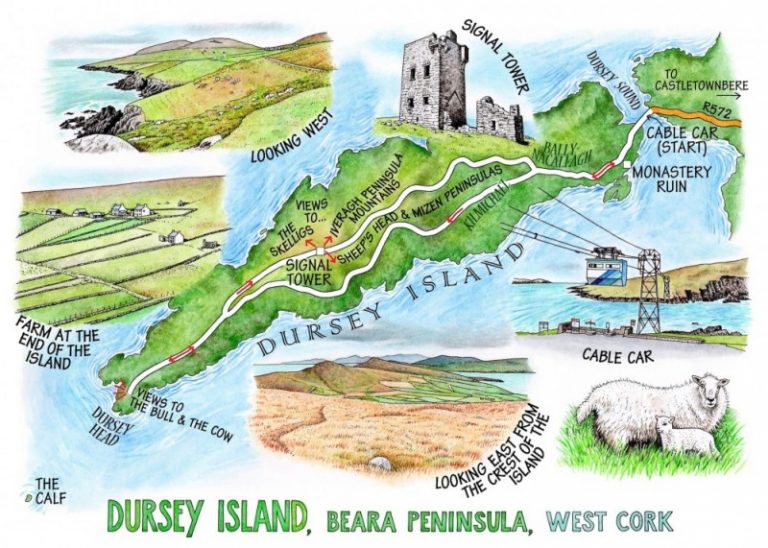
‘A fine day, at least we’ll hope so,’ smiled the man in the window of the Dursey Island cable car ticket office. He waved a hand northward, indicating a slate black sky marching swiftly in over the tip of the Beara Peninsula. The sea in the narrow sound between the mainland and island thrashed and heaved itself up the cliffs in feathery bursts of white foam, legacy of last night’s storm force winds and driving rain. The day might have been going to turn out fine, or not so fine, or not in the slightest bit fine; but down in outermost west Cork they keep an optimistic tongue in their heads. As it was, Jane and I got the usual mixture of four vigorous seasons in one day – and all the better for that.
It must have been a jolting old passage by boat out to Dursey before they put in the cable car in 1969. Nowadays you sway rather than toss, hanging in the little blue camouflaged cabin that hums out under the cables spanning the sound. There was plenty of straw and a fine smell of sheep in the car, even though no animals are supposed to be carried in it nowadays – health and safety, you see.
We disembarked at the northern tip of Dursey Island and the brisk north-east wind blew us on down the island’s rollercoaster of a road, a single track one with a green grass strip up the middle. Month-old lambs were bouncing around the fields, butting milk out of their mother’s udders. We watched the shepherd chasing one, slipping and sliding before he managed to corner it. He marched off towards the farmhouse with the little white creature tucked kicking under one arm.
The sea ran jade-green before the wind, its surface wrinkling into a silvery skin under the strong sunlight, its margins bashing in white froth against the black rocks of Crow Head across the sound. We stopped to listen. Nothing whatsoever, apart from the thump of the sea, the hiss of foam and a faint whistle in the wing feathers of a low-flying herring gull overhead.
Beyond the scatter of green and white houses and old stone ruins that composes Dursey’s village of Kilmichael, the road narrowed and ran as a bumpy track along a ledge towards the outer tip of the island. Someone with an acute but bizarre sense of humour had placed a ‘100 kph’ speed limit sign here. We walked on past neat old field walls, their stones laid in herringbone pattern, where the island birds perched unafraid of our presence – meadow pipits, skylarks, wheatears with white rumps, and a magnificent stonechat in his mating finery of velvet-black head, white collar and brilliant apricot breast.
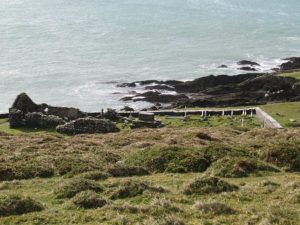
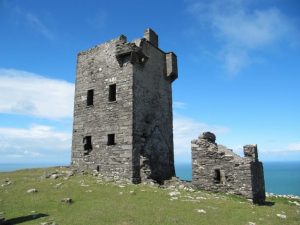
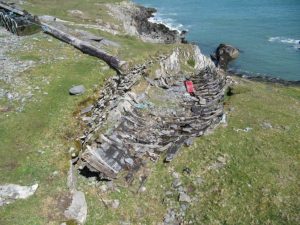
Out at the tip of Dursey we paused to look down on The Calf, a small rocky island like a sea monster with the tower on its summit forming a tiny square head. Then we took to a mountain path, turning back up the spine of Dursey over heather and gorse until we topped out at the gaunt signal tower of forbidding black stone that stands at the apex of the island. The view was entirely sensational – south to The Calf and its parent islands of The Cow and The Bull in their collars of foam, north to the great dark triangles of the Skelligs on the horizon, and further round to the mountains of the Iveragh peninsula, a pale blue and golden dream of peaks and clouds. Behind us the Sheep’s Head and Mizen peninsulas stretched their long, humpy dinosaur necks out low along the southern sea in subtle quarter tones of grey and mauve.
This is a prospect to hold you all day, but not with the mother of all rainstorms slowly advancing to veil the Iveragh mountains. We skeltered down from the tower and back along the green roads under Dursey’s hilly backbone, until the wind-whipped sound and the tiny swaying cable car cabin hove in sight once more.
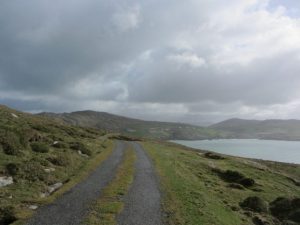
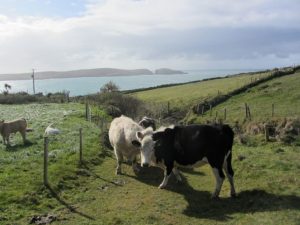
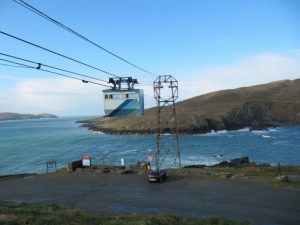
WAY TO GO
MAP: OS of Ireland 1:50,000 Discovery Sheet 84; downloadable map/instructions at discoverireland.ie/walking.
GPS: satmap.com
TRAVEL: N71 (Kenmare-Bantry) to Glengarriff, R572 to Dursey Island cable car.
Cable car €8 p.p. return; timetable 0900-1030, 1430-1630, 1900-1930.
WALK DIRECTIONS: From cable car, follow island road (‘Low route’) through Ballynacallagh and Kilmichael villages, and on to end of road. Here turn right (‘Mountain route’) up spine of island to tower; follow yellow ‘walking man’ signs along green roads back to cable car.
LENGTH: 10 km/6 miles – allow 3-4 hours
GRADE: Moderate
CONDITIONS: Tarmac road, mountain paths
DON’T MISS:
• Ruins of monastic church on your left just after disembarking from the cable car
• Views over The Calf from Dursey Head, and over The Cow, The Bull and the Skelligs from the path up to the signal tower
• Small birds of the island – meadow pipits, skylarks, stonechats, pied wagtails, wrens – all unfazed by humans
REFRESHMENTS: Picnic up at the signal tower. Cup of tea at Allihies Copper Mine Museum café (April-October daily; lovely home-made cakes) – 027-73218.
ACCOMMODATION: Summer Hill B&B, Droum North, Castletownbere (027-70417) – €70 dble B&B; eat at Jack Patrick’s restaurant, Castletownbere (027-70319).
WALKING IN IRELAND: Walking tour operators, local walks including Discover Ireland’s National Loop Walks, walking festivals throughout Ireland: discoverireland.ie/walking.
BOOK: Christopher’s book, Walking In Ireland (Ebury Press), contains 50 of his favourite Irish Independent Walks.
INFORMATION: Castletownbere TIC (027-70054; www.bearatourism.com)
www.christophersomerville.co.uk
map by Claire Littlejohn claire.littlejohn@btinternet.com
I really intend to save this particular posting, Dursey Island, West Cork
I loved the drawings of the walks!
Yes, that’s the brilliant Claire Littlejohn. She makes them come alive superbly on the page.
Christopher